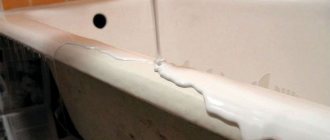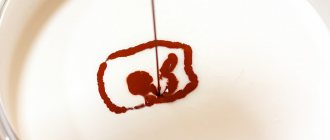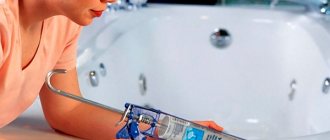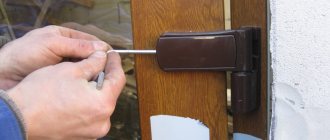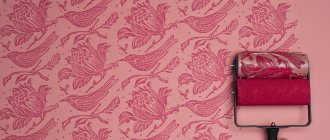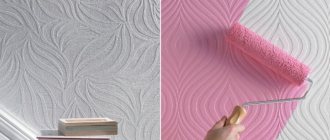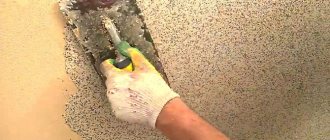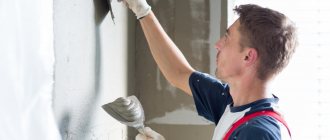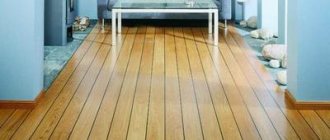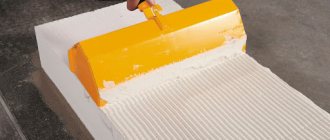Sooner or later, a moment comes when the condition of the old steel or cast iron bathtub ceases to suit the apartment owners. The enamel layer wears out, becomes covered with a fine network of cracks, and loses its snow-white appearance. Deep chips of the enamel are also possible - for a cast iron bathtub they can be regarded as a nuisance, but for a steel bathtub they often become completely fatal, since corrosion eats through the metal.
Painting a bathtub with acrylic
Should you immediately consider purchasing a new bathtub? This option sometimes turns into a complete renovation. Imagine that you have to “pick out” the bathtub from under the lining, thereby damaging the finish, dismantle it, try to carefully pull it out of the cramped room, carry it down the corridor, and then up the stairs to the street. In a word, a very difficult task, especially if a heavy and extremely clumsy cast-iron model is removed. Therefore, many zealous owners pay attention to the possibilities of restoration work.
For example, painting a bathtub with acrylic can come to the rescue. A similar “fill-in” technology includes coating an old surface with epoxy enamel. The “bath in bath” method is also widely used, that is, installing an acrylic liner. In order to be able to decide on the choice of material and the technology for its use, it makes sense to consider all three methods.
Features of the procedure
Restoration using the liquid method can be carried out on cast iron, steel, acrylic bathtubs without large through cracks.
The process takes relatively little time, but requires proper preparation. After complete hardening, a layer of 3 to 5 mm is formed, which can hide all imperfections and last for a decent number of years.
The advantages of such restoration are obvious:
- the bathtub bowl remains in place, no transportation or dismantling is required;
- the protective and decorative properties of acrylic are restored in full;
- You can entrust it to a professional or do it yourself;
- it is possible to repeat the application after some time;
- many compositions can be tinted, it is easy to change the color of the bath to any desired one;
- the surface is leveled, cracks are filled, preventing the growth of mold and mildew and further cracking.
Flaws:
- some formulations have an unpleasant odor and can cause chemical burns if used incorrectly;
- It takes at least one and a half days to dry, ideally 2-3, but different options are possible depending on the concentration of the composition;
- caring for a new surface should be carried out only with special products for acrylic, which are not always cheap.
At the same time, repairs are much more cost-effective than buying a new high-quality bathtub. In addition, the work requires tools that not everyone has. Their purchase will be justified only when renovating expensive bathtubs. In other cases, it is easier to entrust the procedure to a professional.
How to choose paint
The composition for painting a cast iron bathtub is selected taking into account the properties of the future coating, and attention is paid to the shelf life of the material. If the composition is two-component, the period is indicated for the main composition; for the hardener it is not so important.
There are two types of paints for restoring a cast iron bathtub:
- Epoxy enamel. The thick mixture includes a base with a plasticizer and a hardener.
- Acrylic. The composition does not use a plasticizer; it is stirred for a long time, but application is easier than when using epoxy material.
What matters is the possibility of coloring with pigment, the absence of a strong odor, and ease of use. Take into account the color of the hardening component if a snow-white surface is needed, since tinted ones give a gray or beige tint.
Epoxy resin enamels:
- Epoxin 51C and 51 are manufactured by a Russian company and use raw materials from German manufacturers;
- Dulux - made in the UK;
- Tikkurila - made in Finland;
- Jobi - Germany.
OLYMPUS DIGITAL CAMERA
Brands of acrylic paints : Ekovanna, Plastol, Stacril Ecolor, FINNACRYL . The last two are more difficult to prepare and paint, but the result is the most durable of all types.
Required Tools
Before you go for the liquid acrylic itself, you will need to inspect your supplies for the rest of what you need. In this way, you will be able to avoid a second visit to the store by purchasing everything on the list in one go.
The toolkit will include:
- sandpaper/sander/drill with a sanding disc with appropriate pads. The sandpaper must be on a waterproof fabric fastener. With its help, the old coating will be cleaned. You will need at least 5 sheets. For cast iron, steel and secondary restoration of any bath – grades P60, P40. For acrylic – P80, P100. Secondary restoration is recommended to be carried out only with the help of equipment, since a thicker layer will have to be removed;
- degreaser. Solvents such as White Spirit (647), 646 and any similar products are suitable. Some people opt for soda, but this is not a very good option for ensuring good adhesion of the surface to the composition;
- a screwdriver or screwdrivers with a straight and Phillips end, a low basin and rags. Will be needed to remove the drain;
- covering film, masking or fastening tape. To protect walls, taps and floors. The width of the tape is from 5 cm or more;
- clean spatula 10-15 cm wide. Plastic or rubber with a comfortable handle for applying the solution;
- spatula or construction mixer for mixing the solution. A wooden stick or a narrow plastic spatula about 40 cm long is enough. But some people like to use a mixer or a mixer attachment on a hammer drill;
- bath putty;
- flashlight.
You will also need a knife or scissors on hand to cut the tape. It is convenient to have a stool or chair nearby. The work is carried out at a low height from the floor, so bending down each time or picking it up from a chair is a personal choice of convenience for everyone. It’s a good idea to stock up on a hair dryer to blow away dust and speed up the drying of the bowl after washing.
Be sure to have protective equipment: overalls or a jacket with long arms complete with trousers, rubber gloves, a respirator, goggles.
All this will protect a person from an aggressive solution. It is highly advisable to wear a headdress to prevent hair from getting onto the surface during processing.
Surface preparation
Before carrying out the work, it is necessary to prepare in advance those tools that will be needed during the restoration process.
Usually for this purpose the following devices are required:
- Cleaning powder, any available;
- Stiff brush and sponge;
- Sandpaper of different grain sizes;
- Any solvent or anti-grease agent;
- A brush, always with soft bristles;
- Lint-free towel or soft cloth;
- Other materials: polyethylene (to cover other items), masking tape, gloves (it’s better to take rubber ones), a respirator;
- Rust remover.
Buying acrylic
On the shelves of construction and plumbing stores you can find different brands of liquid acrylic. The most reliable are the following compositions:
Plastol. Self-leveling acrylic
Stakryl Ecolor
Ecovanna
Standard
YarLi
These brands have proven themselves highly among professional workers and have been tested for years.
For faster work, you should take more expensive quick-drying options that harden in 24 hours. But long-drying acrylic lays down more firmly, so it is always preferable.
To calculate the required amount, you will need to measure the size of the bath bowl. For 1.5 m you will need about 3-3.5 kg of composition, that is, 1-2 cans, depending on the volume of production.
If you are planning a colored bath, you will need a color that is compatible with acrylic (indicated on the package). The number of packages is selected according to the desired shade intensity.
Preparatory work
The restoration procedure begins with preparing the bathroom. All moving objects are taken out of it, the baseboards are removed from the sides, the ventilation grille, stationary pieces of furniture, faucet and floors are covered with film.
In this way, the bathroom is protected from excess dust and falling elements during operation, and the objects themselves will remain unstained. It is advisable to tilt the tap and shower head as far as possible towards the wall and secure it with tape. Next, they begin to clean the surface.
Bowls with deep cracks will need to be sealed with a special putty. After they dry, they move on to other manipulations.
Stripping
Use sandpaper or a sanding device to sand the surface.
If the bathroom has been previously restored, the coating is completely removed. If the treatment is primary, moderate cleaning is sufficient to improve adhesion. Moderation of treatment is determined by touch and color. The walls should get rid of yellowness, lighten, and become slightly rough. A perfectly smooth surface will not work, nor will deep scratches.
It is faster and more convenient to carry out the procedure with the help of devices. This way it is easier to form the correct curves of the bowl and evenly remove the old layer. Finally, large debris is collected with a vacuum cleaner or manually using a sponge and dustpan.
Washing
After cleaning with sandpaper, you will need to remove the resulting dust. The bathtub itself, the surrounding tiles, and any remaining objects are washed with hot water from the shower head. The film can be carefully removed, rolled up and replaced with a new one. This makes it easier and faster to collect dust for disposal.
Experts recommend washing all surfaces with liquid dishwashing gel or sanitary ware.
Drying and dismantling the drain
After washing, dry the bathtub with a hair dryer or wipe with a cloth.
In the case of fabric, it is extremely important to use a lint-free flannel or microfiber so that particles do not remain on the sides of the bowl. Natural drying does not guarantee the absence of dust, so a hair dryer is the optimal solution. Next, you need to remove the drain so as not to clog it with acrylic. Turn off the water, unscrew the clamps using screwdrivers, and carefully remove them. The water is poured into a prepared basin and collected with a rag.
The basin is drained and placed back under the hole, which is dried again. You can only use film, but a container is preferable for collecting dripping acrylic drops.
Degreasing
A solvent or other selected composition is applied to a lint-free rag or sponge. Wipe the entire surface of the bath. Leave until completely dry or use a hair dryer. Can be repeated 2-3 times.
Correction of minor defects
You don't always need to resort to a complete bathroom renovation. If there are very few defects and chips, they can be eliminated locally. You can repair scratches and other damage using a special restoration kit. The kit usually includes: sanding paper, rubber block, cloth, enamel, hardener, polishing paste.
Defect elimination method:
- Treat the damaged area with an anti-corrosion agent.
- Clean the surface with powder or dishwashing detergent.
- Degrease the coating using acetone.
- Apply the selected substance to the chip.
- Wait for it to dry and clean the surface.
- If necessary, paint over the mark with a paint that matches the tone.
Working with liquid acrylic
When the preparation is complete, you can move on to acrylic.
Preparation of the solution
Put clean gloves on your hands and carefully open the lid of the composition so that dust and dirt do not get in. One-component acrylic is thoroughly mixed, two-component acrylic is combined with a hardener and also mixed until smooth.
Stirring the composition continues for at least 5 minutes. It is necessary to collect all drops from the walls of the container so that the acrylic hardens evenly after application.
Before pouring, the bath solution is allowed to stand for 5-7 minutes. It is important not to overcook the mixture, otherwise it will be impossible to distribute the cured acrylic.
When tinting acrylic, the toner is added at the mixing stage, 3 minutes after the hardener.
Application to the bath
Acrylic is poured evenly over the top of the bowl walls. Next, use a spatula to help distribute the liquid down to the drain. When the entire bath is covered, zigzag across the bottom. Soft rubber spatulas leave the least streaks. Leave the mixture for 5 minutes so that it settles and the excess flows into the hole.
After the specified interval, you need to check the coating for defects of “unpainted paint”. To do this, turn off the lights and carefully inspect the bathtub with a flashlight for smudges, drops, and bare areas. All imperfections are smoothed out with a spatula.
If air bubbles form on the surface, it is good to remove them with a hairdryer. At low speed they drive near the surface with quick movements for several seconds.
The covered bath is left for the time specified by the manufacturer, STRICTLY with the door closed.
If possible, it is worth waiting a little longer than the prescribed period, since each apartment has its own microclimate, and this error must be taken into account.
Before first use, install the drain back, turn on the water, and check for leaks. You can lightly wash the bowl with a special mild detergent.
Bathtub restoration with epoxy enamel
The technology of restoring a bathtub coating using epoxy enamel cannot be called new, since it has been widely used for more than thirty years. The restoration process is somewhat reminiscent of painting, but the coating composition is significantly different from conventional paint.
There are two types of compositions on sale - professional, used by craftsmen working with special tools, and enamel, intended for independent work.
The mixtures differ in their consistency. Professional ones have a lower density, that is, they are liquid, since they are applied to surfaces in several layers using spray guns. This process is quite long, since each layer must dry thoroughly before applying the next one.
Do-it-yourself materials are thicker, so they are somewhat easier to work with.
In addition to the above options, you can find a reducing agent in aerosol cans on sale. These compounds are easy and quick to apply, but, unfortunately, the material is not particularly durable, and its service life is no more than one year.
"Epoksin" - enamel for restoring bathtubs.
Epoxy compositions, just like acrylic enamels, are two-component mixtures. For independent restoration work, they most often purchase “Epoksin” and “Epovin” - domestically produced kits. These compounds take quite a long time to harden, but are affordable.
"Reflex 50" for restoration of bathtub coverings
Another, more expensive version of the composition for the restoration of bathtubs is the development of the Finnish one, which is familiar to many for the high quality of its products. To restore bathtubs, this manufacturer presents the composition “Reflex 50”.
Features of working with epoxy enamel
The two-component epoxy composition has specific properties that differ significantly from the characteristics of acrylic materials. Therefore, they should be known and taken into account even at the stage of acquiring everything you need.
- It is very important to choose the right paint color and take into account that it should differ from the color of the old coating by more than one or two tones. If the bathtub is, for example, blue in color, and it is planned to give it a snow-white color, all operations, including preparation, will have to be performed several times until the old coating is completely covered. Otherwise, the coloring will simply look sloppy and uneven.
- Another point that must be taken into account when choosing epoxy compounds is that such a two-component mixture, after combining the two components, must be used for a fairly limited period of time. Therefore, when purchasing paint, you must carefully read the instructions from the manufacturer. The period of setting and beginning of hardening can vary from 30 minutes to four hours. Once the mixture begins to thicken, it will no longer lie evenly on the surface of the bath. Taking into account this property of the material and the existing experience in working with the epoxy mixture, it is necessary to mix such an amount that is guaranteed to be produced within the time specified by the manufacturer.
Instructions for using a specific composition and its characteristics are located on the original packaging.
- Different compositions have different drying times for each layer. For example, the first layer of Reflex 50 sets within the first hour after application to the surface if the room temperature is +23 degrees. However, all subsequent layers are applied only eight hours after applying the previous one.
Advantages and disadvantages of epoxy enamel for bathtubs
When choosing this restoration option, you need to have an idea of its “pros” and “cons.”
Its advantages include the following:
- Affordable cost of compositions, compared to analogues.
- The process of applying epoxy enamels is quite simple, so even an inexperienced craftsman can carry out the work by studying the instructions from the manufacturer located on the packaging.
- Due to the thickness and high adhesion of the enamel, it creates a uniform coating and fills cracks, shallow chips and pores of the base well.
- Resistance of the coating to mechanical, chemical and biological influences.
- Long service life of the coating. With intensive use of the bathtub, the epoxy enamel layer will last five to seven years.
- For self-application, you can find compositions on sale that set within 4 hours after mixing, which gives more time for work. If you decide to use an epoxy composition to restore the bathtub, you must choose this particular enamel option.
- This material is suitable for the restoration of both steel and cast iron bathtubs.
The disadvantages of epoxy-based paint include the following:
- A bathtub coated with epoxy enamel is ready for use only 7–8 days after applying the last layer of coating.
- After painting a container with this composition, it is not recommended to enter the bathroom for two or three days, so as not to raise dust in the room, which will settle on the undried coating.
- The longer the applied layer of enamel dries, the stronger the coating becomes and more resistant to various influences. Therefore, it is best to paint before leaving for the country or on vacation. In this case, the paint layer will have the opportunity to dry well and harden.
- The coating may turn yellow after a few years. Therefore, it is better to choose not white, but a colored version of the enamel, on which the color change will not be so noticeable.
- An unpleasant smell of paint, which, however, will disappear without a trace after a while.
Carrying out restoration work independently
Tools for working with epoxy enamel
The set of tools for working with epoxy-based composition is somewhat different from the kit for preparing and applying acrylic enamel. So, for the enameling process you will need:
- Professional craftsmen most often use a spray gun, and for self-application they use a roller and a flute brush.
- Tweezers for removing hairs from brushes and rollers.
In addition, you will need masking tape, a knife, newspapers or plastic film to protect surfaces from paint, as well as a degreaser - acetone or white spirit.
A few words need to be said about the peculiarities of working with tools when applying the epoxy mixture:
- Using a spray gun will ensure even coverage of the enamel on the surface. However, it should only be used if you have experience with it.
- If you use a roller for painting, you must have a brush on hand, which is used to level the paint in areas that are difficult for the roller to reach.
- It is best to pour a little paint onto the bottom of the bathtub, and then use a roller to distribute it over the walls and sides. Add paint to the bottom as needed.
- It is not recommended to use only a brush, as it will not provide even coverage. In addition, brush hairs will remain on the surface of the paint.
Restoration of a bathtub with epoxy composition
Now, knowing the basic nuances of working with epoxy enamel, you can move on to considering the process of updating the bathtub.
The appearance of the bathtub before preparing it for painting.
Preparing a bathtub for painting with this composition is no different from similar activities when using acrylic paint - this was discussed in detail above.
The process of applying epoxy enamel to an old coating is also somewhat similar to acrylic, but has some differences.
So, after the stage of preparation and degreasing of surfaces, they proceed to painting operations:
| Illustration | Brief description of the operations performed |
| In the example shown, Tikkurila Reaflex 50 paint was used to restore the bathtub. Mix the base composition with the hardener as specified by the manufacturer in the instructions. When mixing the two ingredients, we must not forget that the pot life of this paint is only 4 hours - this is not short, and there should be enough time for everything. However, it is better to be careful - do not combine the contents of the containers completely. The best option would be to take half of one and the other can. Mixing can be done in a plastic bucket that has been cleaned of used paint compounds. | |
| It is best to place the finished paint on the bottom of the bath - this will help you use it completely to the last drop. Another option, mentioned above, is to pour some of the paint into the bottom of the container, and then distribute it over the surfaces. Here, each master chooses the method that is more convenient for him in his work. In this case, a roller with a compact size was selected for painting, making it possible to dip it into a container of paint. If the roller is larger, you can use a special paint tray or pour paint directly into the bath. | |
| Painting begins from the walls of the bathtub, from the top, gradually descending to its bottom. It is very important to ensure that no smudges remain on the surfaces. If they appear, they must be picked up immediately, distributing the paint to nearby areas without allowing it to set. | |
| The color of the base may show through the first coat of paint applied. It will seem that the paint has applied unevenly - but there is no need to panic. When the bathtub is completely painted, you need to give it time - about two hours - for it to dry. In order for the junction of the paint color of the bathtub and the wall to be even, it is necessary to stick masking tape on the wall in advance, otherwise you will end up with a crooked border, as shown in this illustration. | |
| The second layer will overlap the first, and the coating will become more uniform. You can stop here, since even now the bathtub will differ significantly from its original state - both in appearance and in the smoothness of the walls. | |
| If you want to get a perfectly even color coating, then you should apply another, third layer of paint. However, this process can only be completed after a day, since the first two layers must set very well. After applying the third layer, the bathroom must be closed, preferably for a week, to allow the paint to dry completely. | |
| No earlier than seven days later, the fittings for the drainage system are installed in place. | |
| When finished, the bathtub will acquire a uniform white or other selected color, which will completely cover all the dark areas that appeared on the bathtub during its previous use. |
If there is no roller, the work can be done with a brush, starting from the sides, then moving to the walls and ending with the bottom of the container.
Painting a bathtub with a brush.
Using this tool, you must constantly monitor the hairs left on the surface, which should be immediately removed with tweezers.
Questions and answers
I want a colored bath. Will it be possible to make a bright shade?
The toner should not exceed 3% of the total volume of liquid acrylic (counted together with the solvent if there are two components). How saturated the color will be depends on the specific pigment. It is impossible to increase the volume of the color, as this will violate the properties of the composition.
How to spot fake acrylic?
Popular brands are sometimes actually counterfeited or diluted with solvents to increase sales volume. On originals, information is always printed on the covers or lasered. The information on the hardeners is written in marker. Fakes are supplied with stickers. The seals on the jars must be undamaged. Also, before purchasing, you should study the logos of popular brands and compare the quality of printing, the colors of the label and bottle elements, and the outlines on the packaging.
As can be seen from what has been described, restoring a bathtub with acrylic is not as difficult a procedure as it might seem at first glance. It’s quite comfortable to do all the manipulations yourself if you have the necessary equipment or you can rent it from friends. The work takes a moderate amount of time, but if done carefully, it will please the owner for many years to come.
What is the price?
How much it will ultimately cost to cover a bathtub with acrylic will depend on the artist who will do the work. What are we talking about?
The fact is that if you had your bathtub restored with acrylic by a master of his craft, it will cost from 2 to 4 thousand rubles. Prices vary and it all depends on where you live. For example, in Moscow, covering will cost from 2 thousand and above.
But there is one thing. If the coating is done by a good craftsman, it will last for many years. If we decided to save money, and the acrylic coating was done by a friend of ours who knows everything, then, most likely, the self-leveling acrylic will come off within a year. In this case, we will not save, but will pay several times more later.
Therefore, when talking about the cost of coverage, we must take into account not only how much we are paying today, but also how long the bathtub will last and for how long it will save us from a new restoration.
That is, they called a good master and today they paid him 4000, 10 years passed and 4000 remained and 4000 remained, everything is fine. Or they saved money, called a bad craftsman, paid him 1500, but after 10 years this one and a half thousand turned into 10 - 15 thousand (due to alterations).
And in this article you can read about choosing and installing an acrylic liner in the bathtub
In the case of restoring a bathtub with liquid acrylic, the rule applies 100% - the stingy pays twice.
Besides the work of the master, what else affects the cost? The cost is affected by the size of the bath itself. This is logical, this is the consumption and cost of the material.
And one moment. Perhaps we called a good master, bought a sufficient amount of acrylic, and the master did everything. That's it, the restoration of the bathtub with glass is completed. But a year later, you have to change the bath again and spend money again. What's wrong?
Perhaps the problem is us. If we violate the rules of operation in the bathroom, then most likely it will become unusable in a very short time. Such situations happen often; people still, out of inertia, treat a new acrylic bathtub like an old cast-iron one. Acrylic and cast iron are completely different materials and need to be handled differently. We need to change habits.
For example, in order not to spoil the acrylic coating of the bathtub, you cannot place hard iron objects, basins, or pots in it. Nothing will happen to a cast iron bathtub. Or, for example, we continue by inertia to soak the laundry, as we have always done. Or we bathe our dog in it after going outside.
That is, we continue to treat it like our old bathtub, but we already have a completely different bathtub, made from a completely different material. As a result, after a year the bath needs to be changed again, and money needs to be spent again.
Most likely, we will be disappointed not in our actions, but in the material from which the bathtub is made. He will be to blame, not us.
